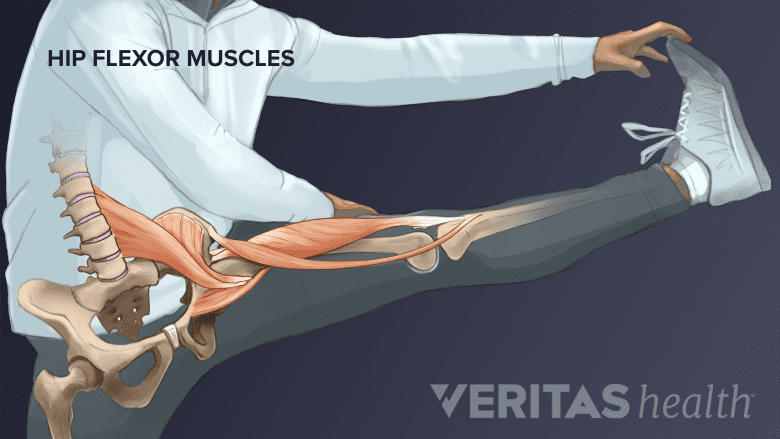Hip flexor pain is a common complaint among physically active people, especially runners and soccer and hockey players. The pain occurs at the hip and/or groin and can make everyday activities, such as lifting a leg to tie a shoe and going up or down stairs, more difficult.

The hip flexors allow the torso to bend forward and move the knee close to the chest.
In This Article:
- Understanding Hip Flexor Pain
- Causes of Hip Flexor Pain
- Video: Kneeling Hip Flexor Stretch
Symptoms of Hip Flexor Pain
Hip flexor pain may develop gradually or appear following a trauma, such as a fall. Many people with hip flexor pain report one or more of the following:
- Constant aching pain or discomfort in the groin or hip, even when sitting
- Decreased range of motion that is especially noticeable when kicking, lunging, running, and bending
- Tenderness, swelling, and bruising in the upper leg or groin; the affected area may hurt when pressed
- Muscle spasms and/or cramping in the hip or thigh that are painful and affect movement
- Weakness in the groin region that may make certain activities, such as kicking, difficult or impossible
- Change in gait, because of pain, decreased range of motion, and other factors affect walking
Hip flexor pain is typically made worse during certain activities or during specific movements, such as:
- Prolonged sitting, such as sitting during the day at an office job or a long car trip
- Going up or down stairs
- Bending the knee to the chest (for example, to tie a shoe)
- Bending over to pick something up
- Pushing off the affected leg to change direction while running or skating
A person does not have to identify with all of these triggers to have hip flexor pain.
Hip Flexor Muscles Anatomy
The hip flexor is not one singular muscle but a group of muscles, including the psoas major, iliacus, rectus femoris, pectineus, and sartorius. (The rectus femoris is also considered a quadricep muscle.) These muscles attach to various points on the spine, pelvis, and femur (thigh bone).
Hip flexors are primarily responsible for bending the torso forward at the hips and moving the leg or knee towards the torso.
How Hip Flexor Pain Develops
Hip flexor pain may develop because of:
- A tear or strain caused by a hip flexor moving beyond its normal range of motion
- Chronic irritation of the hip flexor tendons, which can lead to tendon inflammation and/or damage
- Problems in the hip joint, such as hip impingement, that cause the hip flexor muscles to reflexively tense up (tighten) in order to protect themselves from damage
People often experience 2 or 3 of these problems at once. For example, a problem in the hip joint may cause a hip flexor muscle to tighten, putting it at high risk of tendonitis and tearing.
Getting a Diagnosis for Hip Flexor Pain
Ultimately, there are many reasons a person may experience hip flexor pain. A health care professional, such as a physical therapist, physical medicine and rehabilitation doctor (physiatrist), or orthopedic surgeon can accurately diagnose the underlying cause of hip flexor pain.

